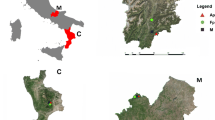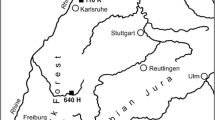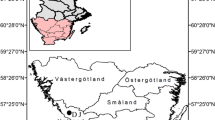Abstract
The influence of climate on the radial growth of Fagus sylvatica was investigated using 15 chronologies developed from mature stands of the French Permanent Plot Network (RENECOFOR) growing under different climatic and soil conditions. The relationships between climate and ring widths were analyzed using extreme growth years, simple correlations and response functions analysis. Monthly climatic regressors were derived by a physiological water balance model that used daily climatic data and stand parameters to estimate soil water deficits. The three most frequent negative pointer years (1959, 1989, 1976) result from a particularly intense and durable drought, whereas positive years (1977, 1958) coincide with wet conditions. The total ring chronology variance attributable to climate averages 34.1% (15.8% –57%). Current early-summer soil water deficit enters in 10 models and the deficit in June explains alone a large part of the radial growth variability (mean value: 26.6%). Temperature or soil water deficit for the other months and weather conditions during the previous season were of little consistency across stands. The response pattern of earlywood is very similar and the percentage of variance explained is higher (16.2% –57.8%). Latewood widths present a different response pattern. High minimum temperature in August and/or September often favour wide latewood widths and monthly water deficits play a secondary role. The percentage of variance explained ranges from 8.8% to 67.4%. Soil water capacity strongly modulates ring characteristics and climate-growth relationships. Mean sensitivity, expressed population signal, signal-to-noise ratio and the strength of growth-climate correlations increase with decreasing soil water capacity.







Similar content being viewed by others
References
Antonova GF, Stasova VV (1993). Effects of environmental factors on wood formation in Scots pine stems. Trees 7:214–219
Antonova GF, Stasova VV (1997). Effects of environmental factors on wood formation larch (Larix sibirica Ldb.) stems. Trees 11:462–468
Aranda I, Gil L, Pardos JA (2000). Water relations and gas exchange in Fagus sylvatica L., and Quercus petraea (Mattuschka) Liebl. in a mixed stand at their southern limit of distribution in Europe. Trees 14:344–352
Aussenac G, (1968) Interception des précipitations par le couvert forestier. Ann Sci For 25:135–156
Badeau V (1995) Etude dendroécologique du hêtre (Fagus sylvatica L.) sur les plateaux calcaires de Lorraine. Influence de la gestion sylvicole. PhD Thesis, Université de Nancy I Henri Poincaré
Barbaroux C, Bréda N (2002). Contrasting distribution and seasonal dynamics of carbohydrate reserves in stem wood of adult ring-porous sessile oak and diffuse-porous beech trees. Tree Physiol 22:1201–1210
Becker M, Niemenen T, Géremia F (1994) Short-term variations and long-term changes in oak productivity in northeastern France. The role of climate and atmospheric CO2. Ann Sci For 51:477–492
Biondi F (1993). Climatic signals in tree rings of Fagus sylvatica L. from the central Apennines, Italy. Acta Oecol 14:57–71
Bouriaud O, Bréda N, Le Moguédec G, Nepveu G (2003) Modeling variability of wood density in beech as affected by ring age, radial growth and climate. Trees 18:264–276
Box GEP, Jenkins GM (1976) Time series analysis: forecasting and control. Holden-Day, Oakland
Bréda N (1994) Analyse du fonctionnement hydrique des chênes sessile (Quercus petraea) et pédonculé (Quercus robur) en conditions naturelles; effets des facteurs du milieu et de l’éclaircie. PhD Thesis, University of Nancy I Henri Poincaré
Bréda N (2003). Ground-based measurements of leaf area index: a review of methods, instruments and current controversies. J Exp Bot 54:2403–2417
Bréda N, Granier A, Aussenac G (1995). Effect of thinning on soil and tree water relations, transpiration and growth in an oak forest (Quercus petraea (Matt.) Liebl.). Tree Physiol 15:295–306
Brêthes A, Ulrich E (1997) Renecofor. Caractéristiques pédologiques des 102 peuplements du réseau. Office National des Forêts, Département des Recherches Techniques, France
Bridge MC, Gasson PE, Cutler DF (1996) Dendroclimatological observations on trees at Kew and Wakehurst place: event and pointer years. Forestry 69:263–269
Briffa KR, Jones PD (1990) Basic chronology statistics and assessment. In: Cook ER, Kairiukstis LA (eds) Methods of dendrochronology. Applications in the environmental sciences. Kluwer, Dordrecht, pp 137–152
Cluzeau C, Ulrich E, Lanier M, Garnier F (1998) Renecofor. Interprétation des mesures dendrométriques de 1991 à 1995 des 102 peuplements du réseau. Office National des Forêts, Département des Recherches Techniques, France
Desplanque C, Rolland C, Schweingruber FH (1999). Influence of species and abiotic factors on extreme tree ring modulation: Picea abies and Abies alba in Tarentaise and Maurienne (French Alps). Trees 13:218–227
Dittmar C, Zech W, Elling W (2003). Growth variations of Common becch (Fagus sylvatica L.) under different climatic and environmental conditions in Europe—a dendroecological study. For Ecol Manage 173:63–78
Dobremez JF, Camaret S, Bourjot L, Ulrich E, Brêthes A, Coquillard P, Dumé G, Dupouey JL, Forgeard F, Gauberville C, Gueugnot J, Picard JF, Savoie JM, Schmitt A, Timbal J, Touffet J, Trémolières M (1997) Renecofor. Inventaire et interprétation de la composition floristique de 101 peuplements du réseau. Office National des Forêts, Département des Recherches Techniques, France
Dupouey JL, Leavitt SW, Choisnel E, Jourdain S (1993). Modelling carbon isotope fractionation in tree rings based on effective evapotranspiration and soil water status. Plant Cell Environ 16:939–947
Eckstein D, Richter K, Aniol RW, Quichel F (1984) Dendroklimatologische untersuchungen zum buchensterben im sudwestlichen vogelsberg. Forstw Cbl 103:274–290
Foster JR, LeBlanc DC (1993). A physiological approach to dendroclimatic modeling of oak radial growth in the midwestern United States. Can J For Res 23:783–798
Fritts HC (1976) Tree-ring and climate, Academic, London
Giles DG, Black TA, Spittlehouse DL (1985). Determination of growing season soil water deficits on a forested slope using water balance analysis. Can J For Res 15:107–114
Gindl W, Grabner M., Wimmer R (2000). The influence of temperature on lignin content in treeline Norway spruce compared with maximum density and ring width. Trees 14:409–414
Granier A, Biron P, Lemoine D (2000). Water balance, transpiration and canopy conductance in two beech stands. Agric For Meteorol 100:291–308
Granier A, Bréda N, Biron P, Villette S (1999). A lumped water balance model to evaluate duration and intensity of drought constraints in forest stands. Ecol Model 116:269–283
Guiot J (1986). ARMA techniques for modelling Tree-ring response to climate and for reconstructing variations of paleoclimates. Ecol Model 33:149–171
Guiot J (1991) The bootstrapped response function. Tree-Ring Bull 51:39–41
Guiot J, Goeury C (1996). PPPBase, a software for statistical analysis of paleoecological and paleoclimatological data. Dendrochronologia 14:295–300
Gutiérrez E (1988). Dendroecological study of Fagus sylvatica L. in the Montseny mountains (Spain). Acta Oecol Oecol Plant 9:301–309
Holmes RL (1994) Dendrochronology program library user’s manual. Laboratory of tree-ring research, University of Arizona, Tucson
Holmsgaard E (1962) Influence of weather on growth and reproduction of beech. Commun Inst For Fenn 55.5:1–4
Lebaube S, Le Goff N, Ottorini JM, Granier A (2000). Carbon balance and tree growth in a Fagus sylvatica stand. Ann For Sci 57:49–61
Lebourgeois F (1997) Renecofor. Etude dendrochronologique des 102 peuplements du réseau. Office National de Forêts, Département des Recherches Techniques, 307 pages
Lebourgeois F, Cousseau G, Ducos Y (2004) Climate-tree-growth relationships of Quercus petraea Mill stand in the Forest of Bercé (Futaie des Clos, Sarthe, France). Ann For Sci 61:361–372
Lebourgeois F, Differt J, Granier A, Bréda N, Ulrich E (2002). Premières observations phénologiques des peuplements du réseau national de suivi à long terme des écosystèmes forestiers (RENECOFOR). Rev For Fr 54:407–418
Lebourgeois F, Granier A, Bréda N (2001) Une analyse des changements climatiques régionaux en France entre 1956 et 1997. Ann For Sci 58:733–754
Lemoine D, Granier A, Cochard H (1999). Mechanism of freeze-induced embolism in Fagus sylvatica L. Trees 13:206–210
Oberhuber W, Stumbock M, Kofler W (1998). Climate-tree-growth relationships of Scots pine stands (Pinus sylvestris L.) exposed to soil dryness. Trees 13:19–27
Penninckx V, Meerts P, Herbauts J, Gruber W (1999). Ring width and element concentrations in beech (Fagus sylvatica L.) from a periurban forest in central Belgium. For Ecol Manage 113:23–33
Piutti E, Cescatti A (1997). A quantitative analysis of the interactions between climatic response and intraspecific competition in European beech. Can J For Res 27:277–284
Raftoyannis Y, Radoglou K (2002). Physiological responses of beech and sessile oak in a natural mixed stand during a dry summer. Ann Bot 89:723–730
Roberston EO, Jozsa LA, Spittlehouse DL (1990). Estimating douglas-fir wood production from soil and climate. Can J For Res 20:357–364
Rozas V (2001). Detecting the impact of climate and disturbances on tree-rings of Fagus sylvatica L. and Quercus robur L. in a lowland forest in Cantabria, Northern Spain. Ann For Sci 58:237–251
Saurer M, Borella S, Schweingruber F, Siegwolf R (1997). Stable carbon isotopes in tree rings of beech: climatic versus site-related influences. Trees 11:291–297
Schweingruber FH, Aellen-Rumo K, Weber U, Wehrli U (1990). Rhythmic growth fluctuations in forest trees of Central Europe and the Front Range in Colorado. Trees 4:99–106
Schmitt U, Möller R, Eckstein D (2000). Seasonal wood formation dynamics of beech (Fagus sylvatica L.) and black locust (Robinia pseudoacacia L.) as determined by the “pinning” technique. J Appl Bot 74:10–16
Tessier L (1989). Spatio-temporal analysis of climate-tree ring relationships. New Phytol 111:517–529
Wickramasinghe A (1988). Modeling tree growth potential based on effective evapotranspiration. For Sci 34:864–881
Wigley TM, Briffa KR, Jones PD (1984). On the average value of correlated time series, with applications in dendroclimatology and hydrometeorology. J Clim Appl Meteorol 23:201–213
Zahner R, Donnelly AR (1967). Refining correlations of water deficits and radial growth in young red pine. Ecology 48:523–530
Zahner R, Stage AR (1966). A procedure for calculating daily moisture stress and its utility in regressions of tree growth on weather. Ecology 47:64–74
Acknowledgements
We thank the European Commission, the French Agricultural Ministry The French National Institute of Forest Research and The French National Forest Office for providing funds to conduct this research (contract DG VI, no. 9760FR0030). We also thank Météo France for their helpful technical assistance for the selection of the meteorological stations
Author information
Authors and Affiliations
Corresponding author
Rights and permissions
About this article
Cite this article
Lebourgeois, F., Bréda, N., Ulrich, E. et al. Climate-tree-growth relationships of European beech (Fagus sylvatica L.) in the French Permanent Plot Network (RENECOFOR). Trees 19, 385–401 (2005). https://doi.org/10.1007/s00468-004-0397-9
Received:
Accepted:
Published:
Issue Date:
DOI: https://doi.org/10.1007/s00468-004-0397-9




